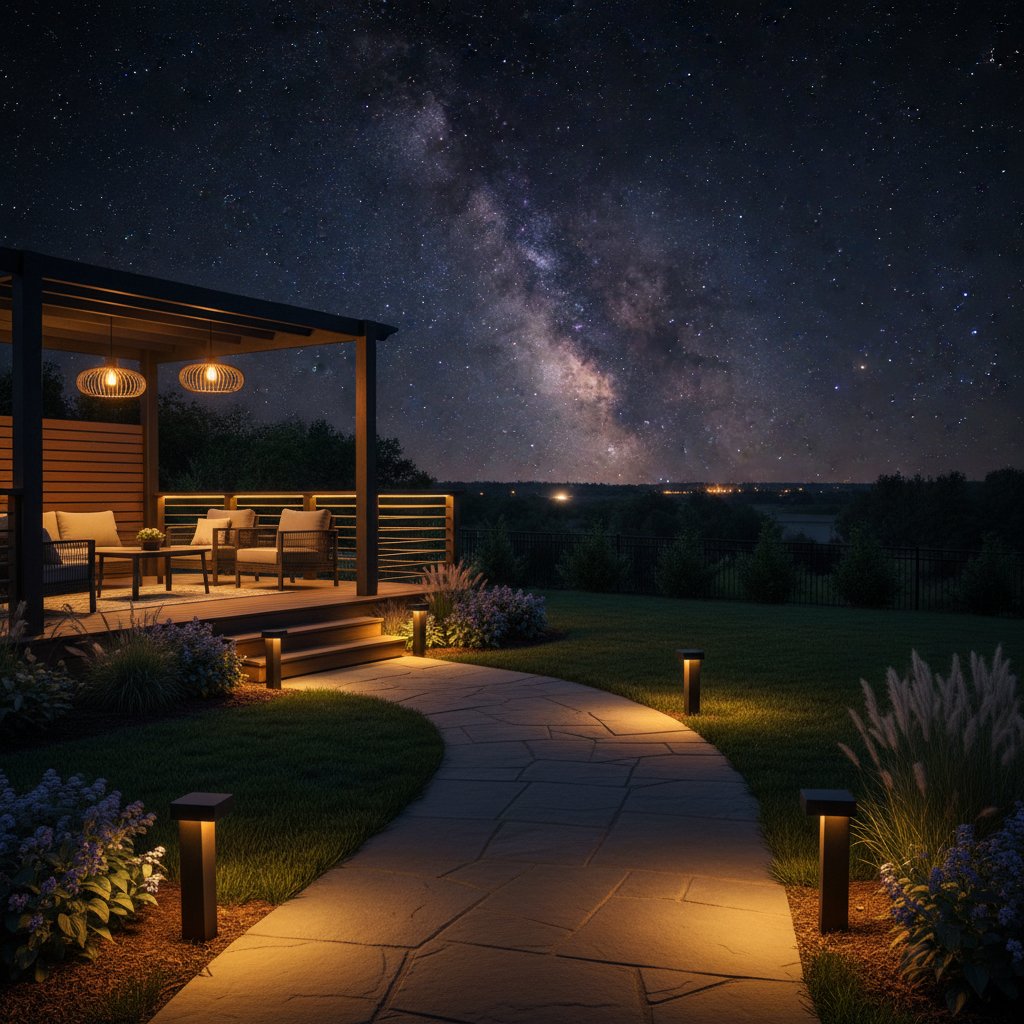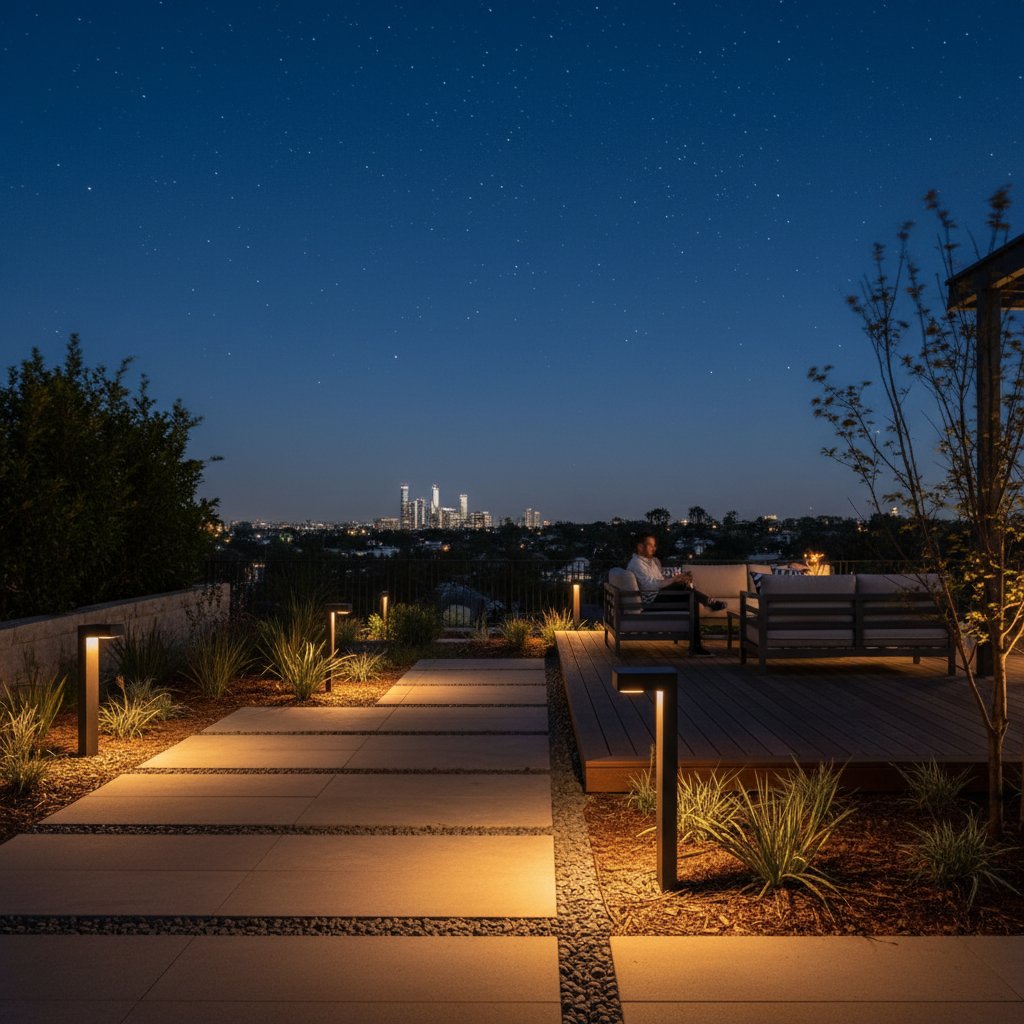Understanding Light Pollution and Its Impact
Light pollution arises when artificial lights illuminate the night sky excessively, diminishing visibility of stars and disrupting natural ecosystems. In residential areas, unshielded outdoor fixtures contribute significantly to this issue, wasting energy and affecting wildlife behaviors such as bird migration and insect navigation. Thoughtful lighting design addresses these concerns by directing illumination precisely where needed, preserving the night's tranquility.
This guide outlines practical steps to redesign your outdoor lighting for 2025. By focusing on efficiency and aesthetics, you create a welcoming yard that harmonizes with the environment. The result offers safety, beauty, and a renewed connection to the cosmos.
Step 1: Assess Your Current Lighting Setup
Begin by conducting a thorough evaluation of your yard after sunset. Walk through the space and observe areas where light spills upward or creates glare, such as unshielded bulbs pointing skyward or overly bright pathways. Identify fixtures that overilluminate sections, leading to uneven shadows or hotspots.
Turn off select lights to test visibility and safety. Note how natural ambient light from the moon or nearby sources influences the scene. This assessment reveals opportunities for reduction, ensuring adjustments target waste without compromising usability.
Step 2: Select Shielded Fixtures for Directed Illumination
Shielded fixtures prevent light from escaping upward, channeling it toward surfaces below. Opt for designs certified by dark-sky organizations, which feature housings that block upward spill. These choices maintain functionality while minimizing pollution.
Recommended Fixture Types
- Pathway Lights: Low-profile models with hooded tops that illuminate walkways without scattering light.
- Wall-Mounted Sconces: Enclosed versions that project light downward onto entryways or patios.
- Recessed Ceiling Lights: Installed in overhangs to wash walls or paths with controlled beams.
- Shielded Spotlights: Directional units with visors to accentuate features like foliage or architecture.
Steer clear of open or spherical designs that diffuse light omnidirectionally. Prioritize durable materials such as corrosion-resistant aluminum or UV-stable plastics, paired with matte finishes to further curb reflections.
Step 3: Choose Warm Color Temperatures and Efficient Bulbs
Color temperature influences both ambiance and pollution levels; warmer hues around 2700K to 3000K mimic natural twilight, reducing harsh blue light that scatters farther. Select LEDs in these ranges for their longevity and low heat output. Pair them with dimmable options to fine-tune intensity based on need.
Incorporate motion sensors or photocells to activate lights only during activity or low natural light. These features prevent constant operation, cutting energy use by up to 50 percent in typical setups. Test bulb placements to ensure even coverage without overlap.
Step 4: Integrate Smart Controls for Precision
Smart systems allow remote adjustment via apps, automating schedules to align with dusk and dawn. Use timers that sync with astronomical data for seasonal accuracy, ensuring lights deactivate promptly. Integrate with home automation for voice or geofence controls, enhancing convenience.
Zoned controls divide your yard into areas, such as pathways versus seating zones, permitting independent dimming. This approach optimizes energy while adapting to usage patterns, like brighter settings for gatherings and softer ones for quiet evenings.
Step 5: Strategize Placement for Purposeful Design
Position lights to emphasize key elements rather than flood the entire area. For accent lighting, angle spots to skim surfaces of trees, sculptures, or water features, creating depth through subtle highlights. Employ silhouetting by placing uplights behind structures to cast intriguing shadows.
Build layers with a combination of task, accent, and ambient sources. Pathway lights guide movement, wall fixtures secure entrances, and low-voltage strings add warmth to gathering spots. Maintain a balance of illuminated and shadowed zones to foster a dynamic, inviting landscape.
Step 6: Establish a Maintenance Routine
Regular upkeep ensures sustained performance and efficiency. Inspect fixtures quarterly to clean lenses from debris accumulation, which can distort beams and increase energy draw. Verify alignments to correct any shifts from weather or growth.
Replace aging bulbs promptly with compatible LEDs to uphold color consistency. Monitor surrounding vegetation, trimming as necessary to avoid interference with light paths or solar-powered units. Document changes in a log to track improvements over time.
Enhancing Aesthetics with Sustainable Design
Intentional lighting elevates landscape beauty by integrating with natural textures. Pair downward beams with stone paths that reflect softly or foliage that filters light for patterned effects. This synergy crafts serene vignettes, such as a lantern-lit arbor framing a stargazing nook.
For gatherings, incorporate low-impact options like solar stakes or rechargeable lanterns. These provide flexible, spill-free illumination that enhances mood without permanent fixtures. The overall effect yields an elegant space where darkness amplifies rather than competes with light.
Realizing Energy Savings and Environmental Gains
Efficient lighting reduces electricity consumption substantially; shielded LEDs with controls can lower outdoor usage by 70 percent compared to traditional setups. This translates to noticeable bill reductions, particularly in larger yards. Longer bulb life further offsets initial costs.
Beyond finances, these measures support biodiversity by preserving habitats for nocturnal species. Healthier ecosystems benefit pollinators and predators, indirectly aiding garden vitality. The investment yields compounding returns in sustainability and enjoyment.
Cultivating a Harmonious Outdoor Haven
As your lighting evolves, observe seasonal shifts in natural light to refine the system. Moon phases and foliage density influence perceived brightness, guiding timely tweaks. This iterative process deepens appreciation for your space's integration with the night.
Ultimately, a refined setup fosters moments of reflection amid balanced illumination. Wildlife returns, stars emerge vividly, and evenings invite prolonged stays. Your yard becomes a testament to mindful stewardship, blending human comfort with natural splendor.



